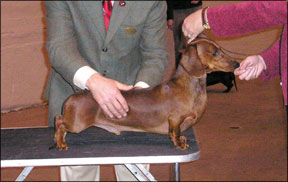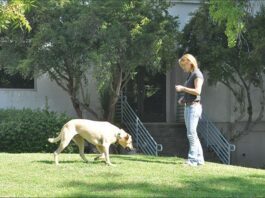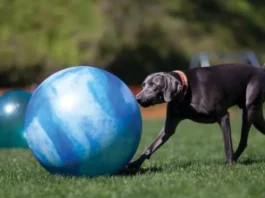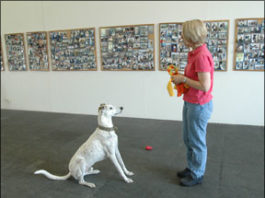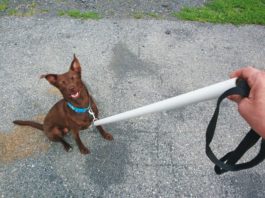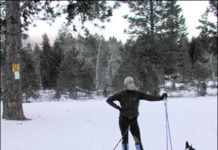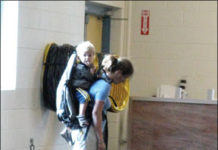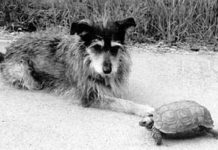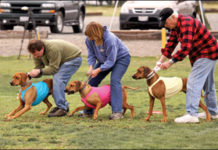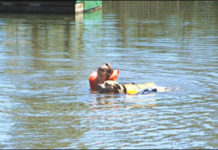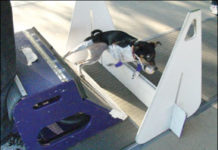Winter Activities You Can Enjoy With Your Dog
courtesy of skijornow.com.üThe author and her dogs
Rally Obedient Dogs
Forward! The judge cues the team to begin. The handler cues her dog to “heel” and, with her left arm bent in at her waist, briskly moves forward with her dog on her left side, heading toward the first in a series of signs that prompt her to cue one of a variety of behaviors. As she completes an “about turn,” a particularly challenging behavior for her long-bodied dog, she smiles, praises him, and moves on to the next sign, attempting to keep up a steady pace around the course of 20 signs. Wait! Did we hear her praise her dog in the ring? Horrors! Surely, the judge made note of that! He’s scribbling furiously now! The handler moves toward another sign and executes the “halt / sit / down / walk around” maneuver. As she releases her dog, she praises him again and even sneaks in a quick pat on the head. She can’t be serious! The judge must be grinding that pencil to a nub now! Does this handler not know that talking or touching your dog in the ring is not allowed? Ah, but therein lies the unique nature of “rally obedience.” It’s not just the signs and the greater variety of behaviors involved; it’s the philosophy of this sport that makes it distinct from its cousin, traditional competition obedience. Rally obedience was envisioned as a sport that would promote the human-canine bond by allowing more natural communication in both training and competition than historically had been available in traditional obedience.
Is Your Dog Hiding a Talent?
All of our dogs are capable of far more than we ever ask of them. Their senses, especially their hearing and ability to smell, are so highly developed that they can perform feats that appear miraculous to us. Their physical abilities can cause us to gape in awe, as demonstrated by the prowess of highly-skilled Frisbee and Agility dogs. And they have all kinds of talents that, unless we look for them, we may never notice; hidden talents that reveal their versatility and breadth of their potential to think, reason and learn.
Get Your Dog Involved In Some Form of Sporting Activity
We have had great fun over the past year and a half, taking a look at 16 different canine sports. The breadth and diversity of activities people undertake with their dogs is truly amazing. Activities that started out simply as something fun to do with your dog have been turned into formal sports complete with rules, regulations, and ribbons. You can swim to boaters' rescue, pull a load of freight, toss plastic discs high into the air for your buddy to catch or, if the mood strikes, dance with your dog. Some sports involve dogs and humans working closely together toward a mutual goal while others provide the dog an opportunity to work independently.
Stretching Your Dog Reduces the Chance of Muscle Tears
All dogs instinctively know how to stretch and do so with great enjoyment. Dogs stretch without fail upon awakening and whenever the mood strikes during the rest of the day. Who hasn’t watched a dog inch his front paws out in front of him as far as possible leaning into the stretch until it literally ripples along the length of his trunk? When the stretch finally reaches the hips, the hind legs are extended far behind the body in what appears to be total ecstasy. The dog completes the routine by dropping to his elbows and stretching the back in a doggy bow that temporarily elevates the rump. Then, the hindquarters flop to the floor in a grand finale to the stretch.
Canine Swimming Lessons: The Perfect Exercise For Your Dog
For those of us who regularly swim for fitness, we know why swimming is often referred to as “the perfect exercise.” In addition to the physical benefits shared with other forms of aerobic exercise, swimming offers some unique benefits. It eliminates the effects of weight-bearing on the joints, exercises the entire body – upper and lower – at the same time, and, in most cases, is something we can do for our entire lives, even if age precludes us from taking part in other forms of exercise. The physical benefits of swimming are the same for your canine companion as they are for you – that is, if you have a dog who will swim. Even though they actually have a stroke named after them, the notion that all dogs are “natural swimmers” is an erroneous one. Some breeds were developed to work in water and are more physically adapted for swimming than others. The problem here is not getting these dogs into the water, but keeping them on terra firma when we want them to stay clean and dry. However, occasionally, even a water breed shows disdain for water – yes, there are some Labrador Retrievers who hate swimming. Conversely, there are dogs you’d never imagine taking kindly to the water who become devoted and skilled swimmers. Although not blessed with the physical advantages of a water breed, and despite sinking rear ends or heavy, wet coats, these Boston Terriers, Rhodesian Ridgebacks, and Siberian Huskies have learned to enjoy swimming. They don’t know or care that they have to work a little harder than a Poodle, Cocker Spaniel, or a Newfoundland – they just want to have fun!
Positive Dog Training for Hunting Dogs
Depending on who you talk to, “hunting dog” means very different things. The only thing in common may very well be that the human end of the leash historically toted a gun in pursuit of some type of “game.” The game in question was not after-dinner parlor entertainment, but the entree on your dinner table. That might be pheasant, duck, or squirrel. Through hundreds of years, the real-life pursuit of food for one’s family has morphed into a competitive sport for people who rely upon Safeway to meet their nutritional needs.
High-Energy Canine Competitions
Woof, yap, scream, yodel, bark, yip. Go, go, go!” Dogs on the sidelines and in crates and exercise pens barking at the top of their lungs. Dogs tugging and growling, tugging and growling. Handlers yelling over the din to their teammates. Handlers recalling their dogs over jumps, H-e-r-e! Event officials blowing whistles and announcing the next race over bullhorns or speaker systems, and start-line lights and passing lights flashing on and off. Flyball is a cacophony of sights and sounds. It is exhilarating, over the top, adrenalized hyperstimulation. This is not a sport for the introverted, timid, or sound-sensitive dog or handler. The adrenalin level is off the charts and you can hear that from hundreds of yards away. The first time I experienced flyball was as a spectator at an obedience trial held at a park. Suddenly, shattering the decorum, was an ear-piercing scream followed by rabid barking. Certain that an obedience dog had left the ring and treed a critter, I raced over to watch. No critter. No mayhem. Just flyball. The teams had just set up for their first race and the dogs were ready. I had never seen dogs so keen to get going.
Canine Water Sports for Aquatic Service Dogs
The curly brown dog stamped his feet and stared at his handler. He had retrieved the plastic dummy countless times. Now what? Something as simple as that look is all it took to start Kathryn Monroe of Mahtomedi, Minnesota, on a quest. It would ultimately take her across the country in search of the knowledge and skills to train her Portuguese Water Dog, Gaucho, to do what his breeding dictated. Work. Water work, specifically. Like many people, Monroe had gotten involved with a breed because she was looking for a dog with an affinity for something she loved. Monroe is a boater. When asked if she had water sports in mind when she chose a PWD, she said, Water sports? I hate water sports! I don't swim
Agility Sports That are Perfect for the Action Junkie in Your Canine
Agility is probably the most popular and best known of all the sports for canine athletes. It's easy to see why. Your dog gets to do what dogs like to do: move around, jump, run, climb on things, and play! Agility is a high-speed sport in which the handler directs her dog through an obstacle course of jumps, tunnels, weave poles, teeter-totter, and other obstacles. The goal is for the dog to complete the course without exceeding the standard course time" and without incurring any "faults." Faults include knocking jump bars
Find Activities That Fit Your Dog’s Personality
There is nothing sadder than the look on my 8-year-old dog Otto's face when he sees me loading my new puppy Woody into the car, on our way to puppy kindergarten classes. This is pretty much the only time I take Woody somewhere and don't ask Otto to come along, too. Otto's expression was so bereft, it got me looking around for some other activity to take up with Otto (and Otto alone).
Dancing With Dogs
Snapping fingers and tapping feet are the signature moves of musical freestyle – and that’s the audience! What happens between dog and handler during a musical freestyle performance is simply magical. The handler gives subtle cues, and her dog executes complicated maneuvers, one after the other, as the pair moves across the floor, their routine choreographed to music that emphasizes their connection. For those of you whose introduction to this sport was watching a widely distributed video clip of Carolyn Scott’s routine to “Grease” with her Golden Retriever, Rookie, you were probably awestruck. You may have even gotten a little misty eyed, recognizing the commitment, training, and connection between two different species. But it was the look on Rookie’s face that sold you that this was a sport worth exploring. This dog was having a blast, and the behaviors he was doing were difficult! How could training something so hard be so fun?


